Recultivation in Halenberg
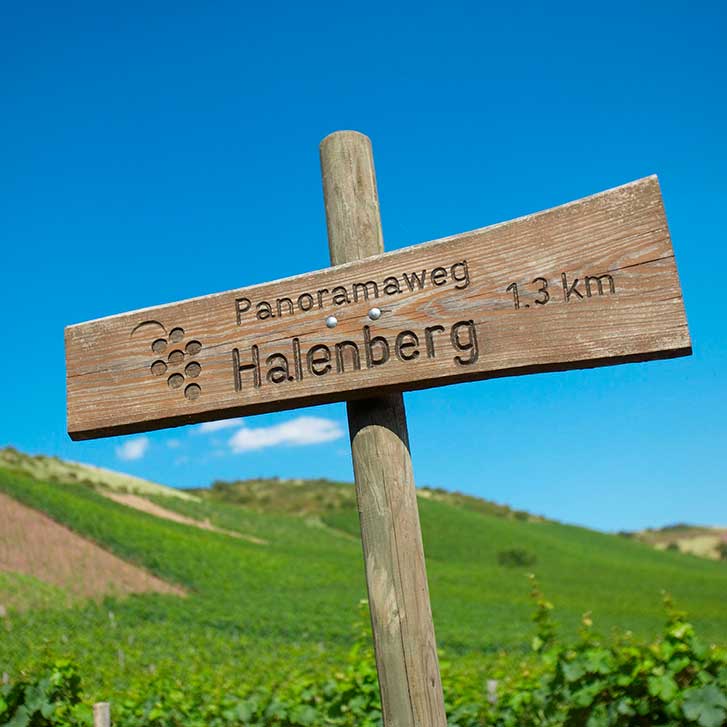
1. Introduction
Imagine: There is a vineyard where top quality is produced over the years. It is considered to be one of the best in the country, probably even worldwide. However, the place next to this top vineyard has been covered with thickets for more than 30 years now. How is this possible? The answer is pretty simple: It is extremely difficult to cultivate this part of the vineyard, no tractor can be used and the soil is far too infertile to get large yield. Is this enough reason? No! Not for us! No longer. Quality has something to do with struggle and suffering too. This is why we decided to struggle a little bit more in the coming years in order to be able to offer more in the future - to you, the enthusiasts of great terroir wines.
It is about a plot of 0.64 hectare in the Halenberg vineyard, which we finally managed to gain possession of in 2006. The plot is next to another one which has been in our possession for year an wich, among ourselves, is called "Lay" meaning slate or rock. The quality obtained from this vineyard in the last years, the classification in the best category of our Prussian Tax map as well as our own knowledge of the geological and microclimate conditions - all of these factors led us finally to the conclusion that it would be a terrible shame if we had left one of the very best parts of the Halenberg with thorny hedges.
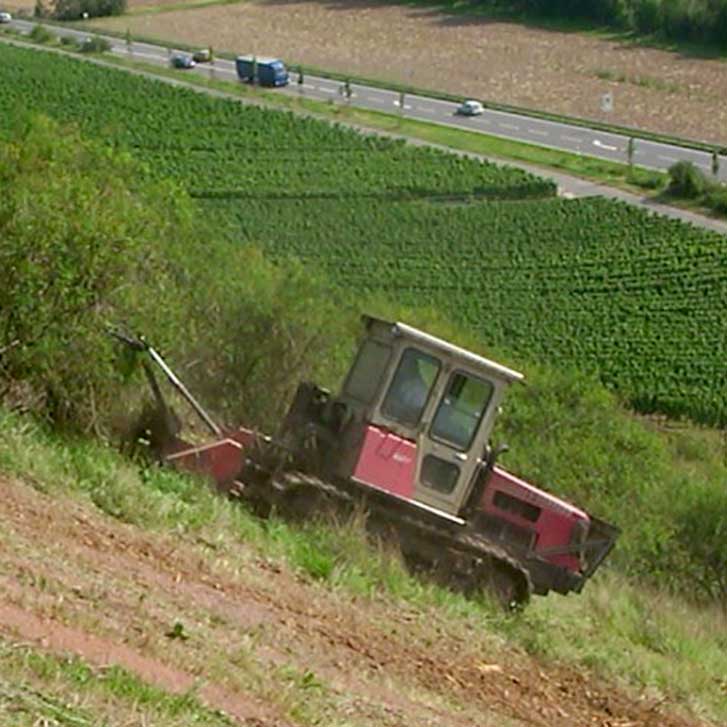
2. Clearing
The supposedly biggest problem could be rather easily dealt with, by using a heavy forest machine. The bushes and small trees that had grown on the plot in the past 30 years had to be removed first. The work would have cost weeks and a lot of sweat by hand. Thanks to this machine, it was done within a day
It is a heavy rubber-tracks-caterpillar equipped with a forest mulcher in front. Climbing up the slope, the mulcher turns everything that is in his way to mulch. Even small trees with 20cm stem thickness do not make any problem. On the way down, the machine chops up the remaining plants and the coarse mulch to make high quality compost material out of them. Because of the incline up to 70%, even the machine driver had serious doubts, whether he could really work the whole area. We were expecting to get horny hands and thorn scratches on the arms, what must have been inevitable, if we had to clear some rest area ourselves. But we were lucky! Our machine driver used his whole skill and actually managed to mulch the whole plot - even though he got stuck and had to start again several times.
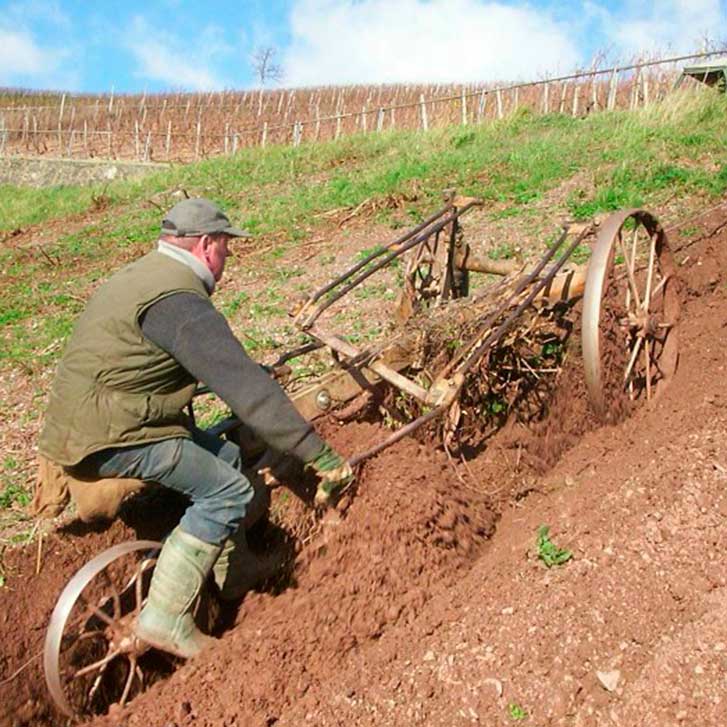
3. Trench Ploughing
Smooth growth of young vines can only be guaranteed, if the delicate roots can easily reach deeper layers in the earth. For this reason, the soil of a new vineyard must always be trench-ploughed. It means the deep loosening and breaking up of the soil. This work can be done with a gang plow or a spade machine on a site where a tractor can move around easily. But on a steep ground such as the Halenberg, we are still have to use this device.
The photo shows a so-called sitting-plough with cable winch traction. Using this device, the work goes uphill. Every time it is pulled up, it ploughs up a strip of land up to 20cm wide and 50-60cm deep. It took four men and three days to plough the whole plot.
We rarely came across rocks during this work against our expectations. Yet, it was not possible to plough deeper than 30cm in some places. The vines will have hard time later in those places. We must probably stabilize the vineyard posts in these places. Fortunately, the most part of the plot has a sufficient thickness of soil - at least 60cm. The soil is stony but quite rich in humus because of the long fallow time. This is the best prerequisite for the production of great wines, as the growth and yield of the vines are much restricted due to the natural conditions.
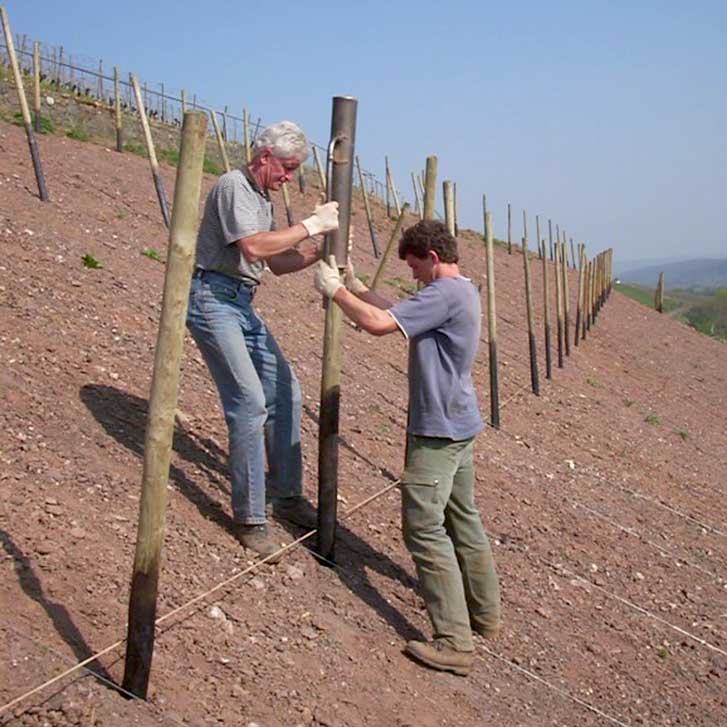
4. Planting
The vines can normally be rather easily planted by machine in a plane or slope field, whereas we are still compelled to plant them by hand in such steep vineyards as the Halenberg. A couple of preparations are necessary for the planting:
First of all, the vineyard was "rowed". It means that die orientations of the vine rows, the distance between the vines and the width of the rows are determined. We decided on a row width of 1.90m and a vine spacing of 1m. It is important to make sure that the rows are not inclined sideways. Otherwise, the working equipments such as tractor, caterpillar or cable winch traction device as in our case would skid sideways too easily and damage the vines. Therefore, foresight is extremely important in determining the rows. Next, we start hammering in the posts or "Stickel". All by hand, of course...
In the end, around 650 poles were placed over the whole plot.
As this work was done and a wire for each row was stretched over the earth, the actual planting could begin. The wire helped us as an orientation, so that the vines were put neatly in a line. The planting holes were prepared with an ground auger - a sweaty one-man job to give the vines new home covered with a bit of fresh planting soil.
It took nearly two weeks for 5 men to put 650 posts and 3600 vines in earth. So we enjoyed a nice glass of Riesling Sekt (sparkling wine) relaxing in a deck chair in the garden after the hard work every evening!
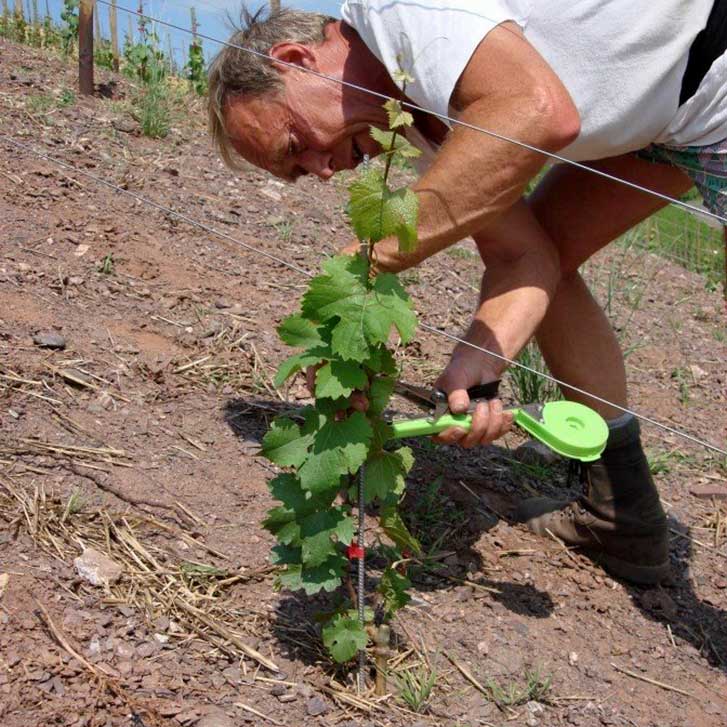
5. Putting up wires and tying up the shoots
About three weeks after planting, almost all the young vines got their first leaves. From then on, the growth picked up. Since the vines develop not only one shoot but several shoots at once, we have to intervene in time. Only the strongest shoot should be retained so that the vine gains height as quick as possible. Also lateral shoots, so-called "Geiztriebe", are therefore of no use for us - they are removed as well. The more frequently this work is done, the better, because this way the waste of energy is limited to a minimum for the vine and the injuries caused by the disbudding remain small.
It won't be long before the young shoots have grown too long to stand without support. It is time to tie them up. A fixing gun dispensing a thin tape is used for this purpose, fixing the shoot to a thin steel rod. But this rod is going to become too short as well in a short period of time, so that we have to put up the rest of the wires immediately in order to be able to fix the long shoots on them. Five wires are required for each row, and they are put up per hand. (Photo right above) It sums up to around 20 kilometers of wire for the total area of this vineyard!
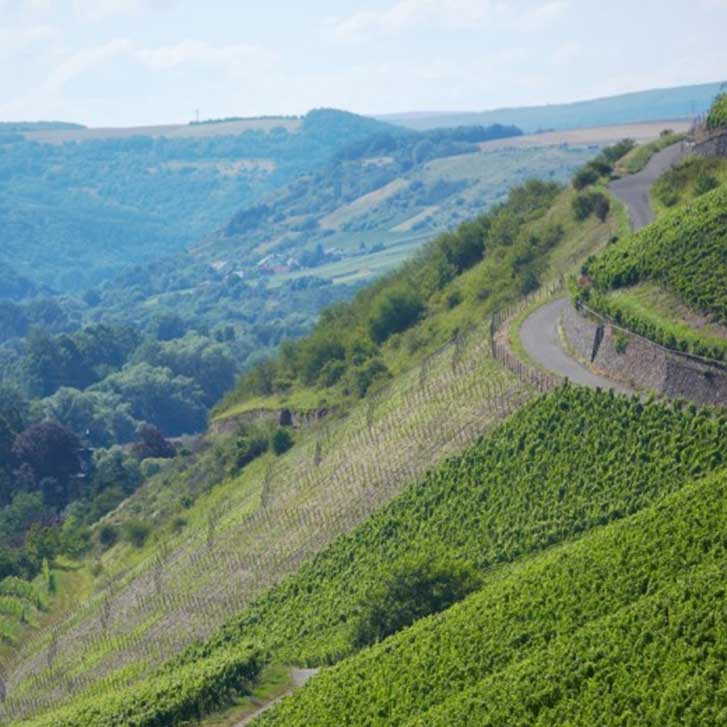
6. Fostering the growth
Now it depends mainly on the weather, how the vines grow. In the year 2007, we have perfect conditions! It is not too hot and we have showers bringing sufficient water into the soil from time to time. It means the young plants do not suffer from thirst at all and grow quickly gaining height. We help them by getting rid of the "spontaneous wild vegetation" (you could call it weeds too). Particularly in the direct vicinity of the vines the use of hoe is required in order to keep away the persistent weeds competing for water.
A wonderful view over the Halenberg with the new plot in the background.
However the principal enemies of the young vines are rabbits and roe deer that stray into our vineyards from time to time and show their particular fondness for shoot tips of young and weak plants. According to our experience, the best way to keep them away is to disgust them. We treat the vines with foliar fertilizer using the knapsack sprayer once a week and the fertilizer starts stinking really "bestially" in a couple of days after it is mixed with water. In this way we are killing two birds with one stone - The vines get additional nutrients which they absorb through their leaves and the rabbits and roe dears stay away from them. 100% natural and very efficient! Again this year it is working perfectly. 95% of the young shoots of our vines have already reached the height of 1.50m, some of them even exceeding two meters.
7. Winter dormancy
If there has been nothing new on this page since August, it is not because I have been lazy in writing, but we just left our young vineyard in peace during the last few months. The only thing we did in September was spreading some straw to protect the soil from erosion in case of heavy rain. Thanks to the optimum weather conditions, the young vines have now reached heights clearly exceeding 2 meters and they are in perfect shape to enter the winter dormancy.
8. Pruning
It is important to prune the vines, before they begin to sprout. Older vines usually lose more than 90 percent of the wood from the previous year through pruning. In the first year after planting, the pruning is usually not so dramatic, since there is only one spur from the previous year. As far as the vine is strong enough, it should be cut back to the height of the trunk at most. If the growth was rather poor, the vine is to be cut back drastically leaving just one or two buds. In our case, the young vines grew very strong, so that we could already form even a small arch. It means that we shorten the vine to approximately 1.60m and then bend it around the upper bending wire in order to tie it on the lower bending wire. Now it is essential, shortly after the sprouting (April/May), to reduce the number of shoots. Otherwise, the strain on the young vine would be too much, and the vine would be permanently weakened.
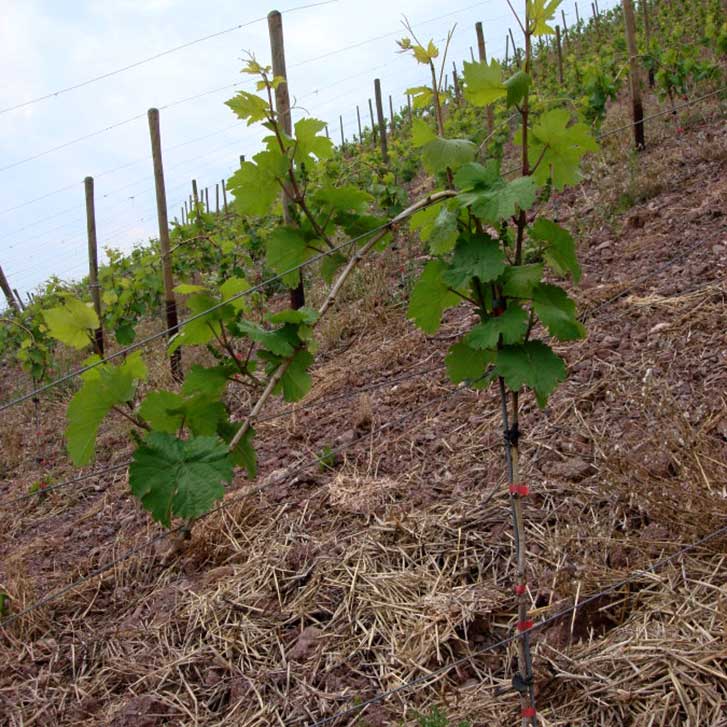
9. Soil tillage and disbudding
Long before the vines begin to sprout again, the weeds shoot up as they always do. It is high time for soil tillage. We now use a light cultivator which is pulled up by a cable winch. Downhill it is pulled down manually. When it goes uphill, one person sits on the cultivator steering it, while the other person controls the cable winch on the tractor. The weeds between the vines, however, must be removed by hands or a hoe.
Shortly after the sprouting, when the shoots are five to ten centimeters long, it is a good moment for disbudding. That means removal of superfluous shoots from the trunk and cordons. We leave up to a maximum of 6 well-positioned shoots on each vine. This is the only way to ensure that the remaining shoots grow strong enough to nourish the first grapes, which we are hoping to harvest as soon as this year.
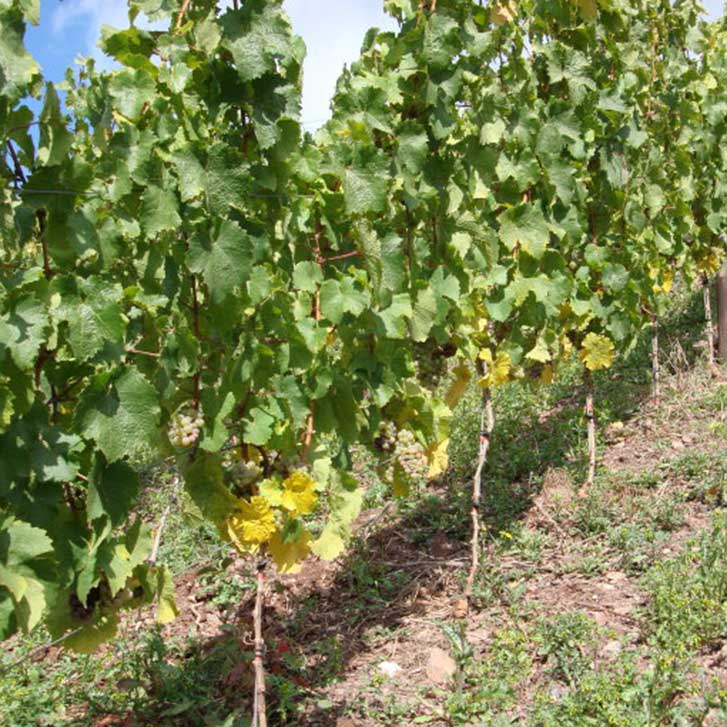
10. Shoot thinning and leaf removal
In spite of relatively dry summer, the vines are growing fairly well again this year. There are only a few weaker vines, of which the number of shoots must be reduced and grapes removed. The stronger ones, however, can keep their grapes in most of the cases. It means we can expect already in 2008 a small amount of wine, which we are going to ferment separately. The longer the shoots grow, the more support they need of the wire frames. The Riesling can hold on to them with its tendrils very firmly, provided that the shoot has so far grown vertically. Therefore, we have to give them some help fixing the shoot between the fixing and tendril wires. Soon the vines will become so tall that we must trim them with hedge shears or a sickle. It prevents the shoots from breaking and improves the aeration in the grape zone, which contributes towards the health of the grapes.
11. Grape harvest
At last - the grapes are ripe! Most of the grapes remained small and therefore very healthy. They are shining golden yellow between the leaves. Here and there, we find some botrytis, called noble rot. It results in that the skin of the grape becomes thin and the water in the grape can easily evaporate. What remains is mainly sugar, acid and a highly concentrated aroma. On the 22nd of October, we were able to harvest the first grapes of our project 2007. We are fully satisfied with the quality and quantity. In any case, we will vinify the must separately, in order to be able to get an impression of the new vineyard's characteristics at the young wine tasting next spring. Possibly, it might end up even in a separate bottling. Let us wait and see.
12. Afterword
It has been two years now since the forest mulcher cleared the space for this unique vineyard. Time flew by. The new vineyard often demanded extra care, which however must not distract us from the work in the existing yielding vineyards too much. The most important steps since then have been described on this page. From now on, we will treat the vineyard, which we ourselves call "young Lay", more or less in the same manner as all the other steep vineyards, the only difference is that we have to make sure in the first years not to overstress the vines with too much yield. Older vines can control it almost on their own. It has been scarcely noticed that we launched another project this year. Our project 2008 is the recultivation of around 1.2 hectare vineyard, parts of which have been abandoned for over thirty years. The new Riesling vineyards are located right above the Halenberg. Having the incline of 40 to 50%, these vineyards are not yet extremely steep in our eyes, but we hope to obtain constantly high qualities in a couple of years on these fields, which could match perfectly our "Mineral" Riesling. We will do our best, so that you can see it for yourself soon.


